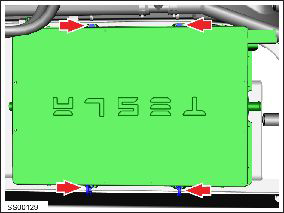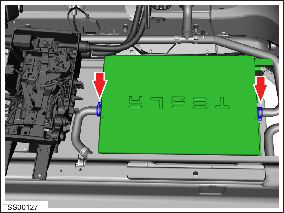Removal
Note: The slave charger is not installed in the vehicle unless it was requested as an
option. The graphics may show both options, Master and Slave chargers, during this
procedure.
- Remove the HV junction box (refer to procedure) .
- Disconnect the harness.
- Peel back the carpet for access to the bolts.
- Remove the nuts (x4) that secure the charger to the floor panel (torque 6.5 Nm).
- Remove the bolt that secures the ground strap to the charger casing (torque 6.5 Nm).
- Position the ground strap aside.
-
Clamp both hoses as close to the charger as possible to minimize coolant loss.
Release the hose clips (x2).
Note: Place suitable absorbent material around the affected area to absorb any possible fluid spillage.Caution: Plug component open ports and disconnected hoses to prevent coolant loss.
- Disconnect both coolant hoses, tilt the charger ports upward, and plug immediately.
- Remove the charger.
-
If the charger is being shipped or stored, allow the coolant to drain from the
charger, then use compressed air lightly to blow out any remaining coolant.
Caution: Do not exceed 25 PSI when using compressed air to blow out any remaining coolant.


